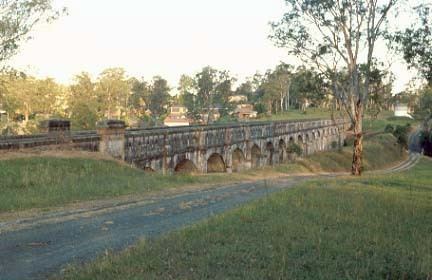Phone +61 2 9604 0563 | ||
 | ||
Area 54.6 hectares (135 acres) Similar Western Sydney Parklands, Bicenten Park, Bike Hire @ Sydney Olympic, Bicycle New South Wales, Parramatta Park | ||
Aerial tour of the lower prospect canal reserve
The Lower Prospect Canal Reserve is a lineal parcel of, primarily, Cumberland Plain Woodland covering 54.6 hectares and stretching 7.7 kilometres through the heart of suburban Sydney, New South Wales, Australia. The corridor stretches from Prospect Reservoir to Sydney Water Pipehead at Albert Street, Guildford with the majority of the reserve located in Greystanes, which is a suburb within the Cumberland Council area.
Contents
The Canal Reserve is one of the last remaining remnants of natural Cumberland Plain woodland in the Sydney basin and contains a number of rare and endangered plant specimens.
The reserve has survived the intense urban development that surrounds it, due to its use, for over 100 years, as part of the water supply system for Sydney. That use came to an end in May 1995, leaving the community with the chance to gain a spectacular parcel of land for recreational purposes. August 2003 saw the reserve opened to the community with a cycleway–walkway running its full length and connecting with other cycleways that extend across a great part of the Sydney metropolitan area.
History
In the 1860s following droughts and population expansion, the need for a larger and more reliable water source was required for Sydney. A Special Commission, in 1869, recommended construction of the Upper Nepean Scheme. The proposal was approved in 1877 and work commenced in 1880.
The Upper Nepean Scheme saw water from the Upper Nepean, Avon, Cordeaux and Cataract Rivers channelled via tunnel, pipes and open canal to Prospect Reservoir. From Prospect Reservoir the water supply moved through an open canal known as the Lower Prospect Canal along the corridor now known as the Lower Prospect Canal Reserve.
The Upper Nepean Scheme is truly a remarkable, even heroic, feat of precision engineering when it is realised that it was constructed without the array of construction equipment and technology that is available today. It was built by hand with the aid of horsepower (real horsepower) and that's it.
The whole scheme relied on gravity and therefore demanded unerring accuracy during construction. The Lower Prospect Canal falls approximately 77 centimetres (30 in) over its 7.7 kilometre length. The scheme, including the Lower Prospect Canal, was completed by 1888.
Controversy
The land corridor occupied by the canal is recognised by the local government and documented for conservation and protection measures.
At the end of April 2008, the final section of the canal leading to the Prospect Reservoir was sectioned off and destroyed as Boral, under direction of the RTA, commenced work on extending Reconciliation Drive from the Prospect industrial zone through to Wetherill Park. Work was scheduled to be completed by mid October 2008 but was still continuing as of early 2013.
This work has proved controversial with the community as a section of the historic canal has been destroyed and a bridge originally promised to traverse the new highway and transitway will now not be built. A previous heritage listed feature of the old Widemere Quarry railway line had been preserved by building the main access road around the old bridge supports. The community is now waging a battle with the NSW State Government to have this decision reversed.
